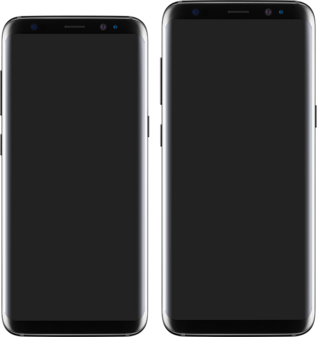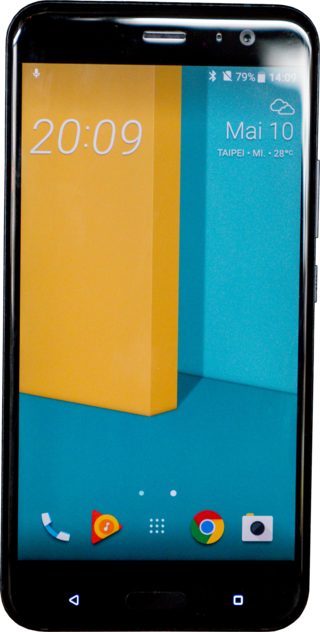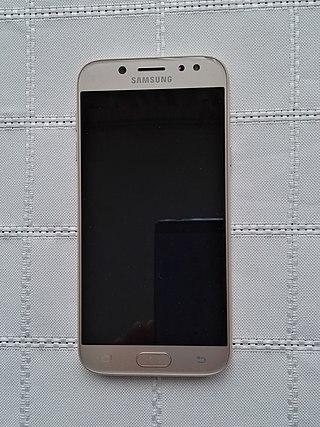Google Nexus is a discontinued line of consumer electronic devices that run the Android operating system. Google managed the design, development, marketing, and support of these devices, but some development and all manufacturing were carried out by partnering with original equipment manufacturers (OEMs). Alongside the main smartphone products, the line also included tablet computers and streaming media players; the Nexus started out in January 2010 and reached its end in October 2016, replaced by Google Pixel.

The Samsung Galaxy S series is a line of flagship Android smartphone and tablet computer produced by Samsung Electronics. In conjunction with the foldable Galaxy Z series, the lineup serves as Samsung's flagship smartphone lineup.

The LG G4 is an Android smartphone developed by LG Electronics as part of the LG G series. Unveiled on 28 April 2015 and first released in South Korea on 29 April 2015 and widely released in June 2015, as the successor to 2014's G3. The G4 is primarily an evolution of the G3, with revisions to its overall design, display and camera.

The LG G5 is an Android smartphone developed by LG Electronics as part of the LG G series. It was announced during Mobile World Congress as the successor to the 2015 LG G4. The G5 is distinguished from its predecessors by its aluminum chassis and a focus on modularity. Its lower housing, which holds the user-replaceable battery, can be slid from the bottom of the device, and replaced by alternative add-on modules that provide additional functions. Two modules are available: a camera grip, and a high-fidelity audio module with DAC. A lower-spec variation, dubbed the LG G5 SE, is available in some markets.

The Samsung Galaxy S7, Samsung Galaxy S7 Edge and Samsung Galaxy S7 Active are Android-based smartphones manufactured, released and marketed by Samsung Electronics. The S7 series serves as the successor to the Galaxy S6, S6 Edge, S6 Edge+ and S6 Active released in 2015. The S7 and S7 Edge were officially unveiled on 21 February 2016 during a Samsung press conference at Mobile World Congress, with a European and North American release on 11 March 2016. The S7 Active was unveiled on 4 June 2016, and released on AT&T in the United States on 10 June 2016.

Moto Z is an Android smartphone developed by Motorola Mobility. Unveiled on June 9, 2016, as its flagship model for the year, the Moto Z is distinguished by the "Moto Mods" technosystem which allows case accessories to be magnetically attached to the device to provide additional functionality. The Moto Z was later joined by the more rugged Moto Z Force of which shares most of the same internals as the former, and the mid-range Moto Z Play with downgraded specifications, all three devices being compatible with the modular system.

Alcatel Idol 4 and Idol 4S are smartphones manufactured by TCL Corporation and marketed by Alcatel Mobile Phones. They were unveiled during Mobile World Congress in February 2016, and are a successor to the Idol 3. The Idol 4 and 4S are positioned as mid-range devices, with the 4S serving as a higher-end model with a faster processor, a larger 1440p display, and a bundled virtual reality headset which serves as the device's packaging.

LG V20 is an Android phone manufactured by LG Electronics, in its LG V series, succeeding the LG V10 released in 2015. Unveiled on September 6, 2016, it was the first phone with the Android Nougat operating system. Like the V10, the V20 has a secondary display panel near the top of the device that can display additional messages and controls, and a quad DAC for audio. The V20 has a user-replaceable battery, unlike its successor, the LG V30, unveiled on 31 August 2017.

The Samsung Galaxy S8 and Samsung Galaxy S8+ are Android smartphones produced by Samsung Electronics as the eighth generation of the Samsung Galaxy S series. The S8 and S8+ were unveiled on 29 March 2017 and directly succeeded the Samsung Galaxy S7 and S7 Edge, with a North American release on 21 April 2017 and international rollout throughout April and May. The Samsung Galaxy S8 Active was announced on 8 August 2017 and is exclusive to certain U.S. cellular carriers.

Moto G5 is a series of Android smartphones developed by Motorola Mobility, a subsidiary of Lenovo. It is the fifth generation of the Moto G family. Announced as successors to the Moto G4, they were first released in March 2017 in several markets including India and Europe. The original variants are the Moto G5 and Moto G5 Plus, the latter also being available as an Amazon Prime version in the United States. The mid-cycle updates, the Moto G5s and Moto G5s Plus, were released in August 2017.

The HTC U11 is an Android smartphone manufactured and sold by HTC as part of the HTC U series. It was announced on 16 May 2017 and succeeds the HTC 10 smartphone. In the United States, the HTC U11's major carrier is Sprint; however, it is also compatible with unlocked carriers, such as AT&T, T-Mobile, and Verizon.

LG K10 (2017) is a mid-range Android smartphone developed by LG Electronics and released in February 2017. As the successor to last year's model, the 2017 LG K10 has a number of improvements over its predecessor, such as a fingerprint sensor and a redesigned form factor, along with Android Nougat as the default operating system.

The Samsung Galaxy Note 8 is an Android-based smartphone phablet designed, developed, produced and marketed by Samsung Electronics. The successor to the discontinued Samsung Galaxy Note 7, Samsung Galaxy Note Fan Edition and Samsung Galaxy Note 5, it was unveiled on 23 August 2017 and became available on 15 September 2017.

The LG V30 is an Android phablet manufactured by LG Electronics as part of the LG V series. Unveiled on 31 August 2017 as the successor to the LG V20, the V30 forgoes the V20's secondary display for a "floating bar" which has nearly the same functions as the second display. It still features quad DACs for improved audio.
The LG K series is a line of mid-range smartphones which are designed, developed and marketed by LG Electronics, which run the Android mobile operating system.

The Samsung Galaxy S9 and S9+ are Android-based smartphones unveiled, manufactured, released and marketed by Samsung Electronics as part of the Samsung Galaxy S series. The devices were revealed at the Mobile World Congress in Barcelona on 25 February 2018, as the successors to the Samsung Galaxy S8 and S8+.

Samsung Galaxy J5 2017 is an Android-based smartphone produced, released and marketed by Samsung Electronics. It was unveiled and released in July 2017 along with the Samsung Galaxy J3 (2017). It has an advanced 64-bit class system on a chip (SoC) backed by 2 GB or 3 GB Of LPDDR3 RAM. It packs a Non-removable 3000 mAh battery. The Galaxy J5 (2017) is the successor to the Samsung Galaxy J5 (2016).
The LG G7 ThinQ, commonly referred to as just LG G7, is an Android smartphone developed by LG Electronics as part of the LG G series. It was officially announced on May 2, 2018, after about a week of official leaks by LG. It is the second product from LG that uses the ThinQ branding. The device serves as the successor to the 2017 LG G6.

The Samsung Galaxy M30 is an Android phablet produced by Samsung Electronics. It was unveiled on 27 February 2019. The phone comes with Android 8 (Oreo) with Samsung's proprietary One UI skin, 32, 64 or 128 GB of internal storage, and a 5000 mAh Li-Po battery.

The POCO X3,POCO X3 NFC and POCO X3 Pro are Android-based smartphones developed by Xiaomi, announced on 7 and 22 September 2020. The phone has a FHD+ IPS LCD 120Hz 6.67" display, a 48 MP wide, 8 MP ultra-wide, 2 MP macro, and 2 MP depth camera, a 5160 mAh battery, up to 8GB RAM and a side-mounted fingerprint sensor.

















